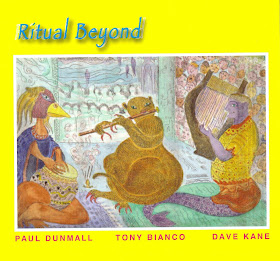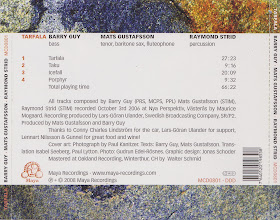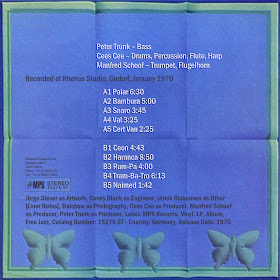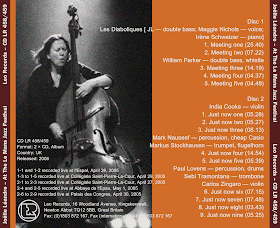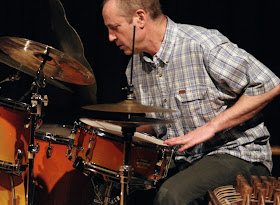Thursday, May 30, 2013
PAUL DUNMALL / TONY BIANCO / DAVE KANE – Ritual Beyond (2010)
Label: FMR Records – FMRCD286-0210
Format: CD, Album; Country: UK - Released: 2010
Style: Free Jazz, Free Improvisation
Recorded at Delbury Hall, Shropshire, United Kingdom, 2009-07-15
CD layout (front cover reproduced above) by Ewan Rigg
Packaging: Digipack
Producer By – Trevor Taylor
Recorded By – Chris Trent
Paul Dunmall – tenor saxophone, clarinet; Tony Bianco – drums; Dave Kane – bass
The nature of the music on this album is equally free, but where the sextet album offers free floating, this one is more about free expression, and full of fierce energy too. This energy is largely the result of the powerplay of Tony Bianco on drums, whose unrelenting pounding is taken up quite well by Dave Kane's bass. Both form an incredibly strong backbone for Dunmall's quite jazzy playing, either on bass clarinet or tenor. The trio calms down a little for the third piece, "Sarasiwati", yet not for long. Three musicians in superb doing, yet they are so prolific and their approach is often quite similar, making this album hard to recommend over previous Dunmall albums, but fun it is.
_ by Stef (FreeJazz)
Description:
Featuring Paul Dunmall on tenor sax & clarinet, Dave Kane on contrabass and Tony Bianco on drums. British drum wiz Tony Bianco has worked with Paul Dunmall in a number of duos, trios and a quartet with Alex Van Schlippenbach. Tony has also worked with Elton Dean, Dave Liebman and Evan Parker. Dave Kane is a fine young bassist who is a part of that great trio with Matthew Bourne who have also recorded with Paul Dunmall on a fine Slam CD as well as another quartet disc on Duns. This disc was recorded live (?) at Delbury Hall, the sound is great. Dunmall starts on clarinet while the trio takes off powerfully. Mr. Bianco is a master drummer, as is their bassist Dave Kane. The trio work extremely well spinning furiously together into a whirlwind of exciting connections. Although Paul sounds great on clarinet, when he picks up his tenor half way through the first piece, the temperature starts to rise and the sparks start to fly. At times Tony Bianco sounds like Elvin Jones as he swirls powerfully around his drums. He pushes the rest of the trio higher and higher, unleashing a dynamic force as he goes. This is one tight and profoundly intense trio! If you dig a later Trane-like trio effort, then this one is for you.
_ By BRUCE LEE GALLANTER, Downtown Music Gallery
Links in Comments!
Friday, May 24, 2013
BARRY GUY / MATS GUSTAFSSON / RAYMOND STRID – Tarfala (2008)
Label: Maya Recordings – MCD0801
Format: CD, Album; Country: Switzerland - Released: 2008
Style: Free Improvisation, FreeJazz
Recorded October 3rd 2006 at Nya Perspektiv, Västeras
Artwork [Cover Art Photograph] – Paul Kanitzer
Design [Graphic] – Jonas Schoder
Recorded At – Nya Perspektiv; Mastered At – Oakland Recording
Mastered By – Walter Schmid
Recording produced by Swedish Broadcasting Company, SR/P2.
Mastered at Oakland Recording, Winterthur, CH.
I've read interviews with jazz musicians that have told of their first hearing John Coltrane's LP A Love Supreme (Impulse!,1964) and their seemingly inability to turn over the vinyl and play the second side, fearing that it would not compare to the first side. This listener had a similar experience listening to the first (and title) track of this recording. Clocking in at more than twenty seven minutes, it is an entire meal in itself, leaving one satisfied or wondering if the remaining thirty minutes of music could possibly be as good.
I tell you this, because for the past week I was unable to listen past the first track. And yet, I was thoroughly satiated.
The trio of Barry Guy (bass), Mats Gustafsson (sax), and Raymond Strid (percussion) might be looked upon as a substitute for the infamous Evan Parker/Barry Guy/Paul Lytton trio. But great listeners shouldn't miss this ensemble. The two Swedes, Gustafsson and Strid form a similar improvising trio called GUSH with Sten Sandell, and have played with Guy in some of his various ensembles. These three have in fact recorded together. In 1994 they made a disc You Forgot To Answer (Maya) [soon on this blog], and good luck finding that one.
The title track bears all the fruits of a free-thinking sax/bass/drums session. Gustafsson, the nu-new thing superstar sounds like a DNA spliced offspring of Evan Parker and Peter Brotzmann. He can play the quietest breath key taps where listeners lean forward in their seats to hear to the full metal blasts of Brotzmann's—Machine Gun (FMP,1968)—violence. On the title track he gives us his all with Strid and Guy encouraging his exploits. The energy swells and recesses, popping circuits off the listeners receptors even in the quietest moments.
The much quieter and reflective "Taku" finds Mats switching between saxophone and fluteophone, Guy bending notes in this quasi-ambient setting. As the track progresses, and unravels into a more outward direction, the three stick to small gestures and restraint. The tension building is symbolic of their confident approach. The other relatively quiet track is the jittery interplay on "Porphyr," with a slowly building intensity of Strid's percussion ramblings into solid cymbal work and drumming. Gustafsson blows a marathon baritone saxophone as blunt object of choice.
What listeners anticipate from a Barry Guy recording is shown here with his solid support for partners and his acoustic electronica. Guy has the ability to generate sounds and energy not unlike a producer or DJ covering both the bottom and the background of a recording. The 20- minute "Icefall" finds him standing toe-to-toe with Gustafsson's fire breathing and spreading wave upon wave of dynamic flowing vitality. The track ends with Gustafsson playing some vibrato signaling attention back to the simple percussion, bass, and breath. Indeed, a thing to admire.
By MARK CORROTO, Published: March 15, 2008 (AAJ)
Links in Comments!
Wednesday, May 22, 2013
NEW JAZZ TRIO (Manfred Schoof) – Page One (MPS Rec. 15276 ST / LP-1970)
Label: MPS Records – MPS 15276 ST
Format: Vinyl, LP, Album; Country: Germany - Released: 1970
Style: Free Jazz
Recorded at Rhenus Studio, Godorf, January 1970
Artwork – Jörge Stever
Liner Notes – Ulrich Olshausen
Photography By – Dalchow
Producer – Cees Cee, Manfred Schoof, Peter Trunk
Engineer – Conny Plank
(Vinyl Rip) - Very rare jazz LP on German MPS Records from 1970.
The self-taught first played with the Dutch band The Miller and Jack Sels, Herman Schoonderwalt, Rob Madna, Pim Jacobs, Kenny Drew, Donald Byrd, Wolfgang Dauner and Dusko Goykovich. He became known in the second half of the 1960s as a member of the quartet by Klaus Doldinger. He then played in the New Jazz Trio by Manfred Schoof, but also took up with Olaf Kübler and with Volker Kriegel. He founded his own Perkussionistenquartett, was the first jazz drummer in the Netherlands, who taught at a conservatory, and published the treatise "The drums in jazz." In 1956 he was briefly married to singer Corry Brokken.
PETER TRUNK (born 17 May 1936 in Frankfurt am Main, † 31 December 1973 in New York City) was a German jazz musician (bass, bass guitar, cello), composer and arranger. He first played with the British trumpeter Stu Hamer and the German pianist Werner Giertz. In 1957 he accompanied American jazz stars such as the tenor saxophonist Zoot Sims and drummer Kenny Clarke, 1959 the equally famous tenor saxophonist Stan Getz and the Dutch singer Rita Reys. He was well known by the early bands of Albert Mangelsdorff, in his "jazz ensemble of the Hessischer Rundfunk" he played well. In the early 1960s he was house bassist of the Berlin Jazz premises "Blue Note" (his colleagues were the Dutch and the German pianist January Huydts drummer Joe Nay).
In 1966 he took part in the recordings of the music of the film Will Tremper-film Playgirl part. Under the direction of Peter Thomas can be heard on the soundtrack released on a Philips LP also Klaus Doldinger (sax), Ingfried Hoffmann (Hammond organ) and Rafi Luderitz (drums).
Later trunk was involved with Klaus Doldinger and the orchestra of Kurt Edelhagen. In the years up to his death, he played free jazz in the tradition of Don Cherry and Ornette Coleman, for example, in the new jazz trio with trumpeter Manfred Schoof and drummer Cees See.
His play on the double bass was characterized by a sonorous, full, round tone, melodic and rhythmic precision and a variety of ideas. Also noteworthy are his play on the electric bass and the cello.
In the spring of 1973, Peter Trunk founded his octet sincerely pt with the sheet set Manfred Schoof, Shake Keane and Jiggs Whigham, and the rhythm section of Jasper van't Hof, Sigi Schwab, Peter Trunk, Joe Nay, Curt Cress. He self-produced their first recordings with the new lineup. During the subsequent tour Udo Lindenberg Doldinger's Passport to replace the exchanged Curt Cress. Immediately before the second tour his tragic fate overtook him in New York he was fatally injured in New Year's Eve 1973 by a taxi driver. Trunk was from the late 1950s to 1973, one of the most significant jazz musicians on the European jazz scene.
Schoof studied 1955-1957 at the Music Academy Kassel, 1958-1963 at the Academy of Music in Cologne, where he was a composition student of Bernd Alois Zimmermann. He first played with Fritz Muenzer and Gunter Hampel and with Harald Banter. His first quintet he founded in 1965, this was a pioneering and leading role in the development of free jazz in Europe only to 1967 existing group. "Born of an elaborate compositional frame of reference and a great attention to formal details" is its documented on three albums music "quite in balance of design and compositional freedom". Schoof continued to work with artists such as Albert Mangelsdorff, Peter Brötzmann, Mal Waldron , Irène Schweizer, the Kenny Clarke / Francy Boland Big Band, the Gil Evans Orchestra, the German Allstars and the George Russell Sextet together. He also works with since its incorporation in 1966 at the Globe Unity Orchestra. As an arranger and soloist, he also worked for Kurt Edelhagen.
Also Schoofs interpretations of various works of contemporary music (such as "The Soldier" by Bernd Alois Zimmermann and Johannes Fritsch) caused a sensation. After he appeared in the early 1970s with his New Jazz Trio, which he also a clever improvising string quintet combined, he founded in 1975 his second quintet, which in addition to the Luxembourg bass clarinetist Michel Pilz and the Dutch keyboardist Jasper van't Hof was the rhythm section of the classic Albert Mangelsdorff Quintet (Günter Lenz and Ralf Hübner). The quintet rehearsed with this plate Scales in 1977 "a virtuoso and also colored music, playing together in the intellectual and the emotional in a special way," honored as the great German Record Prize. Schoof in 1980 received the first Price of the Union German jazz musicians. In that year he founded the Schoof Orchestra began in 1982 and a multi-year collaboration with pianist Rainer Brüninghaus. Since 1987 he is member of the George Gruntz Concert Jazz Band and the European Jazz Ensemble. From 1996 on, he played with Albert Mangelsdorff, Klaus Doldinger, Wolfgang Dauner and Eberhard Weber in the lineup Allstar Old Friends.
Although pioneer of free jazz, he has always stressed the bond to form models and chord material of tradition and placed on the desirability auskomponierter games. "His tendency to chromaticism in harmonic-melodic range corresponds to a preference for rhythmic rubato, which are used with a sure sense of tension" (Martin Kunzler). Beyond the jazz he composed choral and orchestral works, including a 1969 first performed with the Berlin Philharmonic Trumpet Concerto, written in 1975 and was commissioned for the Donaueschingen Music Days. He also wrote numerous film and television soundtracks, including the hit series WDR The sparrow from Wallraf Square. He is also involved in the design of the musical program with the mouse.
Since 1972 Manfred Schoof has been a music teacher. He was since 1981 teaches trumpet and jazz history at the Cologne College of Music. He is also a member of the Board of GEMA. He is on the board of the Union of German jazz musician.
In December 2006, Manfred Schoof was awarded the Federal Cross of Merit.
A pleasure for collectors. Enjoy!
Links in Comments!
Monday, May 20, 2013
JOËLLE LÉANDRE – At The Le Mans Jazz Festival 2005 (2CD-2006)
Label: Leo Records – CD LR 458/459
Format: 2 × CD, Album; Country: UK - Released: 2006
Style: Free Jazz, Free Improvisation
Recorded live at the Le Mans Jazz Festival In April/May 2005, France
1-1 and 1-2 recorded live at l'Espal, April 26, 2005
1-3 to 1-5 recorded live at Collégiale Saint-Pierre-La-Cour, April 29, 2005
2-1 to 2-3 recorded live at Collégiale Saint-Pierre-La-Cour, April 27, 2005
2-4 and 2-5 recorded live at Abbaye de l'Epau, May 1, 2005
2-6 to 2-9 recorded live at Palais des Congres, April 30, 2005
In April/May 2005 Joelle Leandre was a resident artist at the Le Mans Jazz Festival. She performed with Les Diaboliques (Maggie Nicols - voice, Irene Schweitzer - piano), William Parker - bass, India Cooke - violin, Markus Stockhausen - trumpet / Mark Nauseef - percussion, electronics, Paul Lovens - drums / Sebi Tramontana - trombone / Carlos Zingaro - violin. These magic performances are documented on the double CD which contain over two hours of music. There is no question this is the strongest CD by Joelle Leandre in the Leo Records catalogue.
– Jan P. Dennis
Some people will notice with slight disappointment that the album features no new partnerships, only lineups that are already documented. That's true, and that's probably why Joëlle Léandre at the LeMans Jazz Festival is not a five-CD box set, but only two discs worth of highlights, which makes it all the better. All five concerts were recorded by master sound engineer Jean-Marc Foussat.
Links in Comments!
Europa Jazz Festival; Joëlle Léandre at the Le Mans Jazz Festival, April/May 2005
Graphic Design:
Europa Jazz Festival 2005, France
Placard - Joëlle Léandre at the Le Mans Jazz Festival, April/May 2005
Artwork and Complete Design by VITKO Salvarica
ART&JAZZ Studio SALVARICA
The Europa Jazz Festival started in 1980 in the town of Le Mans. Every spring, many concerts are held for a large audience in many different places, from Le Mans to Nantes, from Laval to Angers, from Cholet to La Roche-sur-Yon, and from Alençon to Montjean-sur-Loire. The Europa Jazz Festival stage welcomes major figures of European jazz first and foremost, as well as new discoveries, creations and young bands.
Note:
Le compte-rendu complet du final de la 34ème édition de l ’ Europajazz du Mardi 07 Mai au Dimanche 12 Mai 2013 est désormais disponible sur www.culturejazz.fr
Thursday, May 16, 2013
MAX ROACH and CECIL TAYLOR – Historic Concerts 1979 (2CD-1984)
Label: Soul Note – 121100/1-2
Format: 2 × CD, Album; Country: Italy - Released: 1984
Style: Free Improvisation, Free Jazz
Recorded at Mc Millin Theatre Columbia U., New York, December 15, 1979
Executive-producer – Giovanni Bonandrini
Photography By – Collins H. Davis Jr.
Re-Design (inside and page 4) By – ART&JAZZ Studio, By VITKO
Producer – Max Roach
Producer [Concert] – Bill GoldbergRecorded By – Peter Khun
You won’t hear Cecil Taylor on commercial radio these days although back in the sixties I could catch him on WYLD AM&FM, Saturdays 4-7pm on the “ This Is Jazz ” program hosted by Larry McKinley, a popular New Orleans-based DJ (I believe Larry was originally from Chicago). Larry was renown for his weekday morning programs, The Larry and Frank show.
Larry was the straight man and Frank F. Frank was… well, what would you expect with a name like Frank F. Frank. Imagine Langston Hughes’ Jess B. Semple but with an ignant (short for an aggressive but lovable ignorant) New Orleans hipster inclination. Larry used to pinch his nose to do the voice of Frank. The routines were off the chain, including a hilarious pre-taped one-liner that would be inserted at appropriate times when Larry and Frank were discussing something either reprehensible or ridiculous in which some New Orleans citizen was engaged. All of sudden out of nowhere would come a shouting feminine voice: “you just like your old black pa!”
Can you imagine how that sounded on commercial radio? If Larry could get away with that on the weekdays, then Cecil Taylor on the weekends was no surprise. I’d be walking the picket lines with a little portable radio, engaged in our boycott of Canal Street, the main shopping area of that era. We were demanding jobs and equal access to public accommodations in the establishments where our people spent our money.
We were out there for weeks, months, stretching to over a year. Kept at it, and eventually the segregationist barriers fell but it was a long and sometimes wearying trek. Jazz helped sustain me.
Even though I didn’t fully understand Cecil’s music, his thundering crescendos, wild harmonies, and broken-field melodies not only kept my mind occupied, they also ripped open my imagination.
Cecil Taylor helped me think in new ways, especially his trio double-LP with alto saxophonist Jimmy Lyons and drummer Sunny Murray. Nefertiti Beautiful One Has Come was recorded in Copenhagen in 1962.
Murray’s drumming was just as unorthodox as was Cecil’s approach to the piano and could be equally as assaultive. Listening to them together you felt like you were being bombarded by percussion but without a regular beat. They could make you run for cover. Critics often referred to Murray as the perfect percussionist to ride shotgun on Cecil’s sonic explorations. The thought was you needed someone with a non-swing approach to offer the appropriate accompaniment but then in 1979 along comes this historic encounter: Max Roach & Cecil Taylor.
Now, Max Roach is in my estimation the dean of bebop drummers and certainly the greatest exponent of hard bop drumming—in that style, nothing surpasses the Clifford Brown/Max Roach collaborations. But Max was more than a swinger, as a drummer Max was the most complete improviser in the jazz idiom. No other drummer could completely cover so many bases with such deft and adroit instrumentation as Max Roach.
Whether totally solo with just Max and some drums, or in his M ’ Boom all percussion ensemble, or jazz combos, or whatever (especially when that whatever was work with vocalist Abbey Lincoln), not to mention his smoking symphonic orchestra work, Max Roach was the pinnacle of jazz percussion.
But prior to the recording I never would have thunk that Max would be the best drummer to work with Cecil Taylor.
In most cases a drummer working with Cecil was often an attractive but non essential ornament—some glitter or light bulbs but not the tree. On this recording, no matter what Cecil does, Max is right there almost as if Max had a map of Cecil’s imagination and knew what the pianist was going to do a milli-second or so before Cecil hammered out a phrase.
What is really instructive is the reality that Max and Cecil not only had never played together before this recording, even more astounding there was no rehearsal, nothing but mutual respect. They might as well have been from different countries, different languages with only two things in common. First, was their mutual love for improvised music. Second, and most important, was the left/right combination of technical proficiency and open-mindedness.
The recorded concerts was actually two different performances on one night, hence the plural designation. The first concert opened with a short drum solo, followed by a short piano solo, and then a forty-minute duet. The second show was a 38-minute duet that de facto had three movements. On the Mixtape I have included the two short solos and the second duet.
The 2CD recording also includes two interviews with Max and Cecil that have snippets of the concert inserted. Sounds like they could be ten minute radio promotion pieces for college radio, which was back in the late sixties the main broadcast venue for this music.
I’m not going to even try to describe this music. Whatever words I might choose will fail to convey the gigantic, oceanic intensity of this music. I suggest the best way to listen to it is alone with the lights off, no distractions.
I have a bunch of Cecil Taylor recordings including a handful of duets with drummers. This recording is the gold standard. Period. There is no other Taylor with drummer recording that I know of that can match the orgasmic climax of the second concert, nor for that matter the opening of Max punctuating the proceedings with hand percussion of various types. The opening is as fascinating as a Rubik’s cube, different permutations of sound. The closing is a Molotov cocktail of nuclear proportions. This music is the sonic equivalent of smashing atoms, of nuclear fusion.
Nobody can think and execute music that fast. Thinking goes out the window. You have to be, focus on flowing in concert with the interior pulse, except you’re approaching the speed of light, which is why you have to be a technician of the highest order to hang with this shit. Just listening to it is exhausting.
This music is a cosmic gift. Journey with the sounds to the outer zones of your imagination. You will be changed by what you discover.
— Story By K. S.
Links in Comments!
Thursday, May 9, 2013
GEORG GRÄWE with MARCIO MATTOS and MICHAEL VATCHER – Subsymbolism (1998)
Label: Nuscope Recordings – nuscope CD 1002
Format: CD, Album; Country: US - Released: 1998
Style: Free Improvisation, Free Jazz
Recorded in Cologne, Germany on March 15 and 16, 1995 at the LOFT.
Front cover (reproduced above) ceramics by – Marcio Mattos
Producer and Graphic Design by – Russell Summers
Recorded by, Mastered by – Ansgar Ballhorn
Georg Gräwe – Hamburg Steinway D piano
Marcio Mattos – acoustic bass
Michael Vatcher – drums, percussion
"So good to finally see a new American label, run by journalist & friend from Victo fest-Russ Summers, releasing a CD by the cream of European improv-an incredible trio with heavy credentials and the magic to pull it off so successfully. Outstanding pianist-Mr. Graewe has been paving the way for meetings like this to happen by living in Chicago and interacting with its healthy scene for improvisers. His large GrubenKlangOrchestra were a revelation at the old Knit-sitting in a circle in the audience, so the audience felt like it was part of the piece. Bassist-Marcio Mattos-is another contender for free/Euro acoustic storm of sounds, he has played with Evan Parker, Keith Tippett, Elton Dean and Derek Bailey. The ever-marvelous drummer-Michael Vatcher is based in Amsterdam, he has knocked me out on various gigs and recordings-Zorn's Spy Vs. Spy band, the Maarten Altena Ensemble and Tom Cora's The Roof! This is an all powerful improv trio-each one an equal explorer-as secrets unfold- illuminating the depths. Sublime, lines spinning, spilling, slow rocking waves of notes, delicate fragments to vast towers, three masters painting the environment. The crisp and clear recording, as well as the austere grey kettle on the cover, show the release to be well thought out all round. Brilliant playing throughout!"
– BLG
Veteran modern jazz pianist Georg Graewe aligns himself with London based Marcio Mattos (bass) and American drummer Michael Vatcher. “ Subsymbolism ” was originally intended to be a series of Monk interpretations but traversed a different path ultimately evolving into free improvisational performances. Graewe, Mattos and Vatcher have produced a winner! Colorful, spacious, intense and full of depth, Subsymbolism is a mighty foray into modern improvised jazz. “ Region BQ II ” finds Pianist; Graewe experimenting with unconventional phrasing while bassist Mattos compliments with sensational walking bass lines which cover the full spectrum of the instruments capabilities. Here, drummer Vatcher puts on a drum clinic featuring crisp multi-textured snare drum work. Vatcher fluctuates behind his kit, employing rimshots, delicate cymbal work, odd meter rhythms but never deviates from the explosive pulse of Mattos ’ pivotal bass structure. Mattos is the glue that bonds Graewe and Vatcher. Despite the “ free ” motifs, there is a strong suggestion of rhythmic cohesiveness throughout this recording. “ Region BQ II ” serves a s prime example of the group ’ s frequent tempo changes that evolve in a seamless fashion. “ Allures ” teases at first with a few grandiose chords from Graewe but quickly develops into a call and response exercise between the pianist and Vatcher. “ Allures ” evokes images of a lover ’ s quarrel. Vatcher often matches Graewe in a seemingly argumentative dialogue. The pace accelerates into a furious tirade of perpetual motion. “ Stream ” as the title may implicate takes the listener down a winding path that initially reminded this reviewer of Keith Jarrett ’ s acclaimed “ Standards Trio ” ; however, the pianist raises the intensity several notches augmented by a supercharged rhythm section, not to mention an exhilarating polyrhythmic drum solo by Vatcher. “
Subsymbolism ” is an exquisite work that breathes new life into the current state of modern improvised jazz. The tonal quality, performances and top-notch production are superb. A world class effort that challenges perceptions of what jazz should be. Highly Recommended.
_ By GLENN ASTARITA, Published: January 1, 1999 (AAJ)
Links in Comments!
Tuesday, May 7, 2013
IVO PERELMAN QUARTET – The Hour Of The Star (2011)
Label: Leo Records – CD LR 605
Format: CD, Album; Country: UK - Released: Apr 2011
Style: Free Improvisation, Free Jazz
Recorded by Jim Clouse at Park West studios on September 20th, 2010.
Artwork by Ivo Perelman
Packaging: Jewel Tray
"The hour of the Star" by the newly formed all-star Ivo Perelman quartet is a fierce tour-de- force that will leave improv music fans breathless. The mesmerizing interaction between Ivo Perelman (saxophone), Matthew Shipp (piano), Joe Morris (bass) and Gerald Cleaver (drums) proves that intensity and attention to detail can coexist when delivered as a cohesive artistic statement. A band bound for greatness!
_ Leo Records
"A Hora da Estrela" [The Hour of the Star] is the last work by Clarice Lispector, released shortly before his death in 1977. Hour of the Star is the latest album by Ivo Perelman, released by the English label Leo Records, in 2011. After 34 years, the tireless New- York based Brazilian saxophonist and artist revisits the theme accompanied by some of the most creative and active musicians in the current "free- jazz"/improvised music scene. His recent albums have been named after works by Clarice Lispector (Soulstorm, Apple in The Dark, etc.), which seems to have become an obsession for Perelman, translating the essence of Lispector's confusing, distressing, melancholic and, to some extent, liberating character into his music.
Hour of the Star was recorded just one week before the quartet's live debut in São Paulo, in September 2010. This was the first time the four musicians had played together. They had recorded and played as trios and duos, but never as a quartet. I had the chance to see them perform first hand in São Paulo. One could call this quartet a "super group", but I prefer not to refer to them as such, as the term is closely linked to the music of the 1960s and 1970s, made by musicians with inflated egos, which isn't the case with Perelman's quartet.
With each new release, Perelman has continued to develop his technique. His breathing is unique, very characteristic and different from other saxophonists. As soon as one hears his playing you can tell that it is Perelman's. His music is urgent; it has to stretch out from limits and reveal feelings, whatever they may be, to the outside world. His music is challenging. It has become increasingly developed, complex, but without being boring: it encompasses huge energy and creativity. Whenever people think that Ivo's musical career has peaked, he brings out another great record. Hour Of The Star' has the complexity, density and melancholy found in Clarice Lispector's works, but if we close our eyes we can see the abstract paintings directly relayed via Perelman's music.
The release begins with "A Tearful Tale", in a very fragmented and angular way with just Ivo and Shipp; this becomes more cohesive as Morris and Cleaver join in, leading to a peak after almost 13 minutes. "Singing the blues" is what we could call the most "conventional" on this album, followed by the brilliant and powerful "Hour of the Star", the high point of the album. In its 14 minutes, the quartet does not demonstrate any sign of fatigue or lack of creativity. The track is explosive, with impressive interaction between the musicians. It is one of Perelman's best compositions in his long career.
"The Right of Protest" is the shortest piece on the album and also the most melancholic. Shipp and Perelman play it as a duo. "As for the future" is just the trio of Perelman, Morris and Cleaver, while Matthew Shipp lays out. Starting calmly with Cleaver, the track develops in such a way that the listener just has to get involved. Morris and Cleaver provide the necessary support for Perelman to take off on his solos perfectly. It is worth remembering that Joe Morris is a guitarist with a highly personal technique, but recently he has concentrated on playing bass, as he does here. The album closes with "Whistling in the Dark Wind" at the highest level, with Matthew Shipp and his "hammered" piano, while Perelman wrings everything he can out of his sax, stretching the limits of the instrument. A breathtaking close to one of the most sincere, honest and challenging forms of music.
Review by Cláudio PENTERIANI (2011-08-10)
Links in Comments!

